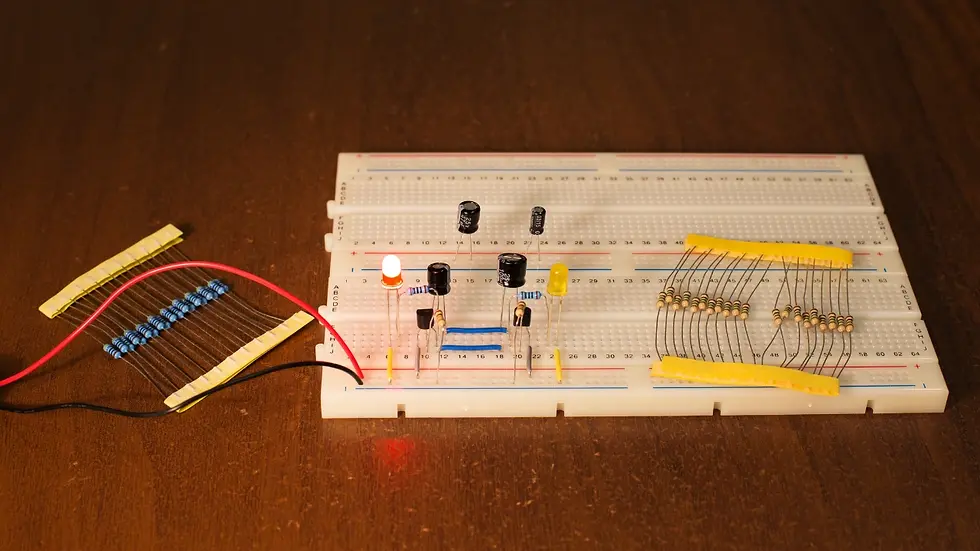What Is GND in Circuits? Meaning, Types, and Why It Is Important?
- Harshit Shah

- Jun 20
- 6 min read
Updated: Aug 8

If you have ever looked at a circuit diagram or worked with electronics, you have likely come across the term GND. Short for ground, GND plays an essential role in every electronic design, yet it is often misunderstood by beginners and sometimes even overlooked in complex projects.
Without a well-designed GND circuit, no electronic device can function reliably. GND provides the reference point for all voltages in the system, helps manage the flow of current, and protects sensitive electronic device components from unexpected electrical events. It forms the invisible backbone of every electronic device
In this blog, we will explore what GND really means in electronic circuits, why it is so important, and how designers can use it effectively.
Table of Contents
What Does Ground (GND) Mean in Electronics Circuits?
In electronics, GND or ground refers to a reference point in the circuit from which voltages are measured. It serves as the shared route through which electric current returns to the power source.
You can think of GND as the point in the circuit that defines zero volts. All other voltages in the system are referenced against this specific point. In addition, the GND circuit provides a safe pathway for unwanted electrical charges, helping maintain stable performance.
Why Is GND Important in Electronic Circuits?

A well-implemented grounded circuit is essential for ensuring that your electronic device operates as intended. Grounding provides the foundation upon which all signals and power are referenced. Without it, electronic circuit components may behave unpredictably or even fail entirely.
Here is why proper grounding is so important:
Provides a consistent voltage reference
GND defines the point of zero volts in the circuit. All other voltages are measured relative to it, which ensures consistent and accurate operation of all components.
Allows current to return safely to the power source
Every current path in the circuit must complete a loop back to its source. The gnd circuit provides the critical return path for current flow, maintaining the balance of energy in the system.
Protects components from static charges and power surges
A well-connected GND can safely redirect electrostatic discharge or surge currents away from sensitive components, reducing the risk of damage.
Minimises electrical noise and interference
Proper grounding helps control electromagnetic interference by providing a low impedance path for high-frequency noise currents, preventing them from coupling into signal lines.
Improves signal integrity
Clean and stable GND references ensure that signals, especially in analogue and digital circuits, maintain their integrity. Without this, data errors, jitter, and unstable operation can occur.
Types of Ground (GND) in Circuits
There is no one-size-fits-all all ground. Different types of GND serve different purposes in modern designs. Here are the most common types:
Earth Ground
Connected to the physical earth, this ground provides a true zero voltage reference and helps protect people and equipment from electric shock.
Chassis Ground
It is often used in metal enclosures, and the chassis is connected to ground to shield the circuit from electromagnetic interference.
Analog Ground
It is used in sensitive analogue sections of a circuit to maintain clean signal paths and reduce noise.
Digital Ground
Provides a return path for digital signals. It is often kept separate from analog ground to avoid introducing noise.
Signal Ground
Used as a reference for GND signal lines, especially in communication circuits.
By understanding these grounding electronic circuits techniques, designers can improve the performance and safety of their products.
You May Also Read: How to Select the Right Electronic Components for Your Design
Purpose of GND in Electronics Circuits

An electrical ground does more than just define a zero-volt reference point. It serves several important functions:
It provides a common return path for the current
Protects against voltage spikes and static charges
It helps maintain proper voltage levels throughout the electronic circuit
It helps minimise unwanted electrical noise and signal disruption
Enhances user safety by preventing electrical hazards in the device
Ground Symbol in Circuit Diagrams
When looking at a schematic, you will often see specific symbols for GND. The most common symbols include:
A downward-facing triangle
Three horizontal lines stacked with decreasing width
A line with three descending lines below it
These symbols all represent a GND connection, but designers sometimes use different versions to indicate separate ground types, such as chassis or analogue ground.
How to Troubleshoot Grounding Issues?
Improper grounding can lead to problems such as unwanted noise, unstable signals, and component damage. Here are some tips for troubleshooting grounding electronic circuits:
Check for broken or loose ground connections
Verify that analogue and digital grounds are separated where needed
Ensure that ground planes are continuous in PCB design
Look for ground loops, which can introduce hum or noise
Test for consistent ground potential across the circuit
Proper troubleshooting can prevent many common issues and help maintain clean signal integrity.
You may also read: What are PCB Vias? A Complete Guide
How Does Grounding Work in PCB Design?
In PCB engineering and design services, careful attention to GND is required for proper circuit performance. For OEMs, design engineers, and contract manufacturers, a well-structured GND circuit reduces the risk of data errors, electromagnetic interference (EMI), and power instability, especially in high-speed or mixed-signal designs.
Here’s how grounding is effectively implemented in modern PCB layouts:
Using a Solid Ground Plane
A continuous, unbroken copper plane is placed on one or more layers of the PCB. This reduces impedance and provides a clean, low-noise return path for high-frequency currents. In multilayer boards, dedicated ground layers help shield signal traces and minimize EMI.
Short and Direct Return Paths
Signals always return to their source through the path of least impedance — which is often the GND circuit. Designers minimise trace length and ensure return paths follow signal lines closely, reducing the loop area and potential interference.
Single Point Grounding for Analog and Digital Circuits
In mixed-signal designs, analog and digital grounds should be separated and connected at a single, controlled point. This prevents digital switching noise from contaminating sensitive analog sections.
Strategic Use of Decoupling Capacitors
Capacitors placed close to IC power pins and tied to the GND plane help stabilize voltage by filtering transient spikes. To perform as intended, these capacitors must be grounded correctly.
Avoiding Ground Loops
Redundant paths between different ground points can cause circulating currents and introduce noise. A sound layout avoids these loops through careful topology and simulation.
Thermal and Mechanical Considerations
Ground planes also serve as heat sinks and mechanical stabilizers. For power devices, thermal vias connected to the GND circuit help distribute heat more effectively.
Interesting reads: Thermal Profiling in PCB Assembly: A Complete Guide
Conclusion
The concept of GND is simple but powerful. It serves as the electrical foundation for every circuit and plays a critical role in stability, performance, and safety.
Understanding how GND works and applying proper grounding electronic circuits techniques can greatly improve your designs. At A2Z Electronics LLC, we bring this level of care and expertise to every project we assemble, helping our clients achieve optimal results.
Looking to partner with an experienced electronic manufacturing company for your next design? Contact A2Z Electronics LLC today to ensure your circuits are grounded for success.
FAQs
Q1.What is Ground in a Circuit?
Ground, often labeled as GND, is a reference point in an electronic circuit that defines zero volts. It provides a unified path for current to return and forms the baseline for measuring voltages and ensuring overall circuit reliability. In PCB design, ground is essential for controlling current flow, minimizing noise, and ensuring signal integrity.
Q2.What does the GND do?
The GND circuit provides several critical functions:
Establishes a stable voltage reference
Offers a safe return path for current
Helps suppress electrical noise and EMI
Protects components from voltage spikes and static discharge
Without a reliable GND connection, the performance and safety of any electronic system can be severely compromised.
Q3. Is GND positive or negative?
GND is neither inherently positive nor negative—it is a reference point. Voltage measurements are made relative to GND. In most DC circuits, GND is considered 0V and is usually tied to the negative terminal of the power supply. However, in dual-supply systems (e.g., ±12V), GND sits between the positive and negative rails.
Q4.What is the difference between Neutral and GND?
In AC power systems, neutral carries current back to the source under normal operation, while ground (or earth ground) is a safety path for fault current. In contrast, in electronic circuits, GND is used as a reference point and return path for signal and power currents—it doesn’t function as a safety line but rather as a design-critical part of the circuit.
Q5.What is the difference between GND and reverse GND?
GND typically refers to the main return path for current and is at 0V reference. Reverse GND might refer to configurations where the GND is tied to the positive terminal (e.g., in PNP transistor circuits or some battery-reversed systems). It’s not a standard term, so context is important—reversed GNDs may be seen in specialised applications or testing environments.
Q6.Can a bad ground cause electronic issues?
Yes, a bad ground can lead to:
Unstable voltage levels
High-frequency noise or EMI
Erratic behaviour of digital logic
Component overheating or failure
In a manufacturing or product design setting, bad grounding can result in product recalls, compliance failures, and increased debugging costs.
Q7.What’s the role of signal ground in PCB design?
Signal ground serves as the reference point for low-level signal voltages. It is often isolated from power or chassis ground to prevent noise from contaminating sensitive analog or communication signals. In high-performance or mixed-signal PCBs, maintaining clean and isolated signal grounds is vital for reducing cross-talk and ensuring accurate data transmission.





